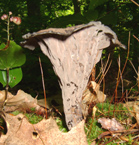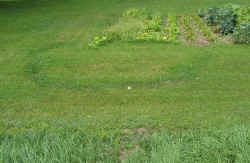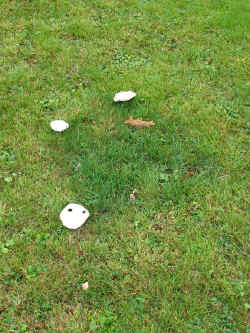|
|
A New England and Eastern Canada Edible and Medicinal Mushroom Resource |
||
|
Know your trees. This is imperative. Many good mushrooms are mycorrhizal. They have a symbiotic relationship (friendly exchange) with trees or other plants. Mushroom mycelium receives carbohydrates and other nutrition from trees while delivering minerals and water. The tree often receives a significant amount of it's water intake by delivery from the extended mycelial network. Both organisms benefit. More than 90% of all plants form beneficial associations with fungus. Fungi can also be saprobic consuming the dead or dying tissue of living trees. These saprobes tend to prefer certain trees. Similarly, parasitic fungi that destroy and consume living tissue tend to be particular about which trees they infect. In Maine, recognizing oak and hemlock is an
absolute requirement. You need to know about many other types of trees and
plants as well. National
Audubon Society Regional Guide to New England Eastern Hemlock associates with dozens of species. King boletes, chanterelles, matsutake, honeys, aborted entoloma and other good boletes are found on the ground. Mature trees will usually be more productive. Hemlock reishi (Ganoderma tsugae) and other shelf mushrooms fruit on dead wood. Oak supports many species including maitake, king boletes, chanterelles, black trumpets, chicken of the woods, blewits, honey mushrooms, oysters and many others. For maitake and many others, you should look for larger, mature trees with possibly some dead wood in the tree. Oak stands with young and middle aged trees are usually not as productive and are best avoided. I often find maitake growing by oaks that are infected with honey mushrooms. Under Eastern White Pine find chanterelles, painted suillus, chicken fat mushrooms, Boletus pinicola/pinophilus (a type of king bolete) and a few others. White, yellow, and other birches can harbor chaga and other polypores on the wood and chanterelles, hedgehogs, boletes, and others on the ground. Mature, scarred, or dying trees usually produce more. Beech are where you find most black trumpets around here. Chanterelles, oysters and hedgehogs are occasionally associated with beech. Maple is a common host for oysters in fall and early winter (Pleurotus ostreatus). In particular, sugar maple is the most likely host. Again, Look for mature, dying, and dead trees. I have found Boletus bicolor, and Craterellus ignicolor and Craterellus tubaeformis near maples. That said, most activity around maple is likely to be on the wood rather than on the ground with species like Pleurotus ostreatus (oyster), Pleurotus dryinus, Polyporus squamosus (dryad's saddle), Volvariella bombycina, Ganoderma applanatum (artist's conk), and Climacodon septentrionale (northern tooth - not edible) being fairly common on the wood. Poplar/Aspen is a common host for oysters in May and June (Pleurotus populinus). Turkey tails are often found on poplar. Many other types of fungi find poplar to be a friendly place. Balsam Fir (the Christmas tree), a very common tree in Maine, often has good stands of chanterelles or boletes beneath it. The various Spruce varieties support a wide variety of mushrooms. Blue spruce, although not native to this area, is fairly common in planted stands and lawns blue spruce supports king boletes, chanterelles, and many other species. Black spruce tends to grow around swamps, streams and sphagnum bogs. Red and white spruce tend toward rockier soil, and hillsides. Positive identification of native spruce varieties can be a challenge but all support mushrooms. Mature, dying, or dead trees should always get extra attention. Maitake, oysters, chicken of the woods, reishi, and turkey tails are found almost exclusively on this type of substrate (growing medium). Look for trees woodpeckers have been working on. Large, mature oaks and sugar maples with dead branches always have excellent potential. Sometimes spotting good trees is easier in the winter. You can always be looking! Chaga and artist's conk can be found year round. Oysters are occasionally found in winter. Cuttings where wood was harvested a few years earlier have lots of stumps where various types of mushrooms may grow. This is especially true for selectively cut wood lots that still offer some shade. Wood harvesting equipment like skidders and harvesters often cause scarring on remaining living trees where various fungi may get a start. I have birches on my property that have chaga on these type of scars. Look for mixed woods. Mixed hardwoods and conifers provide a variety of habitats and many types of mushrooms can possibly be found there. Planted tree stands with just one variety of tree such as eastern white pine or red pine are often unproductive. People told me look for matsutake under Red Pine. I have never found much of anything under red pine except false morels. They may have wanted me to ignore the hemlocks! I will keep looking though. Pastures and other places with very rich soil from manure are places where meadow mushrooms, horse mushrooms, puffballs, and other good coprophilic (dung loving) mushrooms can often be found. Be on the lookout from July through November at these locations. Look for dark green patches or rings in lawns or pastures. Dark green areas of grass are often locations where meadow mushrooms, horse mushrooms, and puffballs, will soon appear. The grass is always greener! It should be ascertained that herbicides have not been used on the lawn. Look for weeds. A weedy lawn is far less likely to have been treated. Edges of parks and cemeteries where grass clippings and leaf compost are deposited are good places to find blewits in the late fall. Cemeteries are always worth a look if they are old and not treated with herbicides. In Maine, there are lots of very old, small, family cemeteries. Often they are mowed just a few times a year. People in Maine tend to care less about killing dandelions, weeds, etc. There seems to be far less herbicide usage in Maine than in Massachusetts and points south. Look for weeds. Woodland trail edges and edges of shaded country dirt roads are often productive and obvious. My theory is that the compacted soil of trails and roads may prevent the mycelium from spreading inducing it to fruit. Embankments that are shaded by trees such as oaks or hemlocks most of the day are good places to look. Trails and back roads with banks that are mossy are excellent bets. The south side of a road or trail is likely to be shadier and mossier. You might notice that on an east to west stretch of road that the south side is mossy and the north side is grassy. Moss of the brushier type like sphagnum moss often have mushrooms growing on or near them. Mosses are a strong indicator when found in a "wash" or on an embankment. I often wonder if some mycorrhizal species associate with mosses. Look near streams, lakes, ponds, bogs and coastal areas. These are microclimates where fog, wet ground, humidity and other factors such as plentiful dead wood and leaves tend to produce mushrooms and other fungi. Near the coast there is a different distribution of trees with oak being more plentiful. Beech, maple, poplar and other hardwoods mixed with various conifers predominate a few miles inland where I live. Look for "washes". Jerry Goguen from Massachusetts got me tuned in to "washes". Washes are intermittent streams on hills, small mountains and in valleys where water rushes through during spring runoff and heavy rainstorms. Sometimes the water will actually create natural dams of dead trees or branches that fall and are washed down the hill and lodge sideways behind living trees. A stone wall or a large rock can also be a dam. Mushrooms like black trumpets and chanterelles tend to proliferate in washes below these dams. Washes can often be followed long distances with phenomenal results (bring your GPS). Shady is better. Once I got the idea of washes, black trumpets seemed to be everywhere. Smell the air. Sometimes you really can smell mushrooms. A large stand black trumpets has a strong smell you may be able to pick up from a distance. Mushroomy woods often have a particular smell. Use of this site will constitute your acceptance of the disclaimer. Copyright 2011 Mushroom-Collecting.com. All rights reserved. |

 is a good reference. Learn to spot the tree species from a distance. I try
to notice the trees that are a quarter of a mile or more ahead of me when
I am driving (so I can continue to watch the road).
is a good reference. Learn to spot the tree species from a distance. I try
to notice the trees that are a quarter of a mile or more ahead of me when
I am driving (so I can continue to watch the road). 
